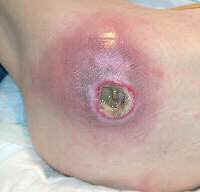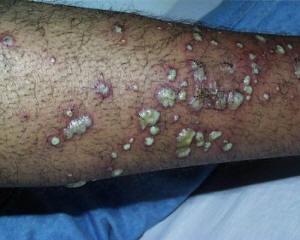Symptoms
One of the unique things about bacteria is that they can be found just about anywhere in the world. They live everywhere including the air, water, land, and even on humans. There are a lot of different types of Staphylococcus aureus, and for the number of types, there are just as many variations in their habitats.
MRSA is a pathogen that lives on humans. It is found most often in the nose, armpit, and groin areas (Harvard Women's Health, 2008), but once you have this infection in your body, it can spread to other parts of the body. Sometimes, these bacteria stick to the skin and causes abscesses there, or they can burrow down beneath the skin to the organs and tissues which can cause huge problems for the victim.
MRSA is obviously a parasite that feeds on its host. Whether it is on your skin consuming your skin cells or in your blood stream feeding on your blood cells, it is harming you in some way.
Another problem with MRSA and bacteria in general is that they reproduce so quickly that they are hard to control once they are in the body. MRSA is no exception, while it takes humans years to mature before reproduction is even possible, bacteria are ready to reproduce upon being formed. Staphylococcus aureus can generate an entire new generation in 27-30 minutes under ideal conditions (www.textbookofbacteriology.net).
Bacteria reproduce by the process of binary fission. Binary fission occurs when a cell replicates its DNA and then attaches itself to the cytoplasmic membrane which elongates and separates the two DNA molecules from one another. The cell then begins to form a cross wall which invaginates the membrane and eventually pinches it off and forms two new cells which are exactly the same. (Freeman, 2005)
MRSA is able to reproduce quickly and can form anywhere on the human body. These two traits cause a lot of problems on the human that it chooses as its host. At the beginning, MRSA can look like small boils or pimples on the skin, but after awhile these small bumps turn into deep painful abscesses that can break through the skin and require surgical draining because of all of the fluid and pus that builds up. (www.mayoclinic.com)
seubert.heid@students.uwlax.edu

